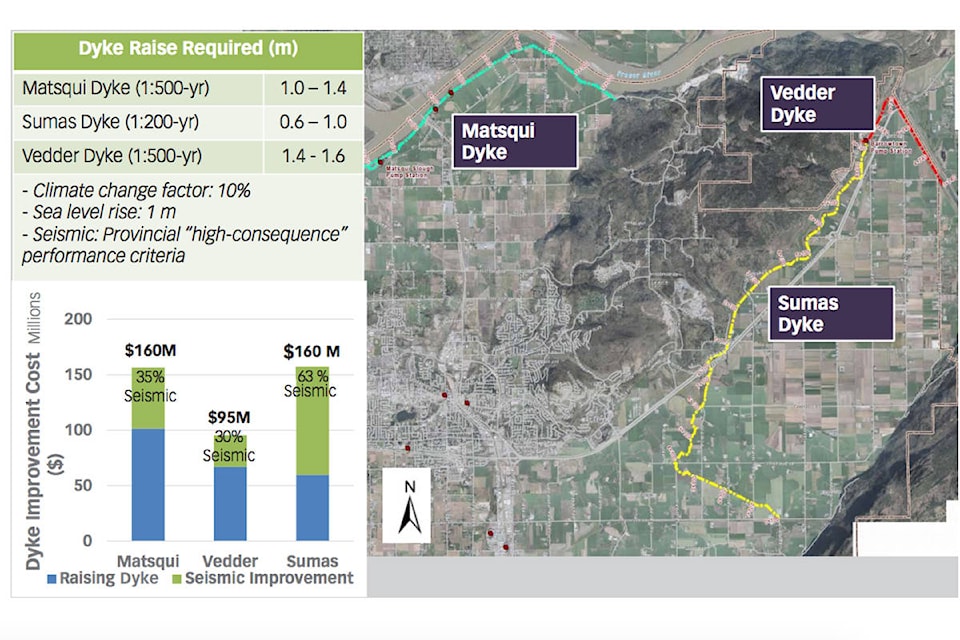Although the city plans to spend some money up front to reduce its own emissions, the effects of ongoing climate change are expected to have a far greater impact on taxpayers over the coming decades.
This week, the city adopted a “green fleet” plan that will see electric vehicles and others with low emissions bought over time to replace gas- and diesel-guzzling cars and trucks. The plan will cost the city around $4 million over the next decade, but pay for itself by reducing Abbotsford’s annual $1.1 million fuel bill.
RELATED: Green fleet will cut emissions and costs, report says
But local taxpayers will have to pay far more over the next two decades in order to react to, and prepare for, the consequences of a change that is expected to continue to change thanks to greenhouse gas emissions.
Adapting to rising sea levels, drier summers and more extreme rainfall events are all projected to cost the city and province tens of millions of dollars over the coming decades.
As the city has created new plans for its growth over the coming decades, staffers have had to consider the cost of a world with a fast-changing climate. The Lower Mainland is expected to get hotter in the summer, while the very wettest days are predicted to be dramatically rainier, according to a 2016 Metro Vancouver report.
Those predictions were factored into the city’s new master plans for the city’s drainage, diking and waste-water systems.
Abbotsford might be some ways from the Pacific Ocean, but even a moderate sea-level change will force the city to spend millions more to floodproof its low-lying areas and valuable infrastructure.
RELATED: ‘Climate change in action:’ Scientist says fires in Alberta linked to climate change
RELATED: Canada may need higher carbon taxes to meet its Paris targets, PBO says
Modelling of Fraser River levels suggest that a sea-level rise of one metre will require dikes and other flood protections to be raised by a similar amount throughout the entire Fraser Valley.
In many areas, the dikes already need to be raised considerably just to meet provincial standards today.
Doing so is expected to cost more than $400 million, a tab city officials want the province to pay.
Meanwhile, the city also plans to spend tens of millions of dollars to floodproof land next to the JAMES water treatment plant to allow for future expansions. Doing so is expected to cost upwards of $47 million.
Like the dikes, some of that floodproofing is necessary even without a forecasted one-metre sea-level rise.
The river isn’t the only issue, though. The very wettest of days are expected to get 60 per cent wetter, according to a Metro Vancouver report.
That will challenge Abbotsford’s infrastructure in the future and should lead to changes in the next update of its development bylaw, according to the city’s new drainage master plan.
And mountain snowpacks are predicted to decrease by between 25 and 50 per cent. That could decrease the recharge rates in Abbotsford and Mission’s reservoirs, increase evaporation from the two sites, and also lead to a hike in demand for water over the summer months.
Higher temperatures and less rain in summer could also compromise the quality of the water, according to a 2017 report.
“The combination of these projected changes to annual and season precipitation patterns and increased temperatures may impact water quality due to increased streambank erosion and sediment accumulation.”
The one bright side is that higher overall precipitation rates could boost the region’s aquifers.
Those factors were all taken into account by staff who recommended the city plan to build a new $85 million collector well to increase Abbotsford and Mission’s total water supply.
“Overall, the performance of the existing sources adequately meets potable supply needs, however, there are limitations in the transmission system when providing MDD conditions today, and there is greater risk of insufficient supply (and transmission) into the future due to growth and climate change.”
@ty_olsen
tolsen@abbynews.com
Like us on Facebook and follow us on Twitter.
